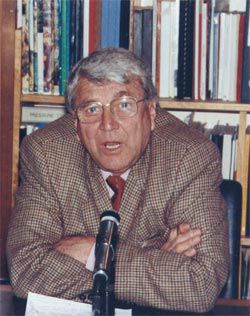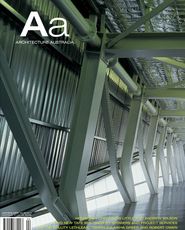Ron Gilling, OBE, LFRAIA, Hon Fellow AIA, made significant contributions to the profession in a number of ways. Don Bailey remembers the name and his efforts.

Ronald Gilling, Architect, older brother to architect Douglas, was the son of an architect who was invalided out of the army after war service in France, and who first went to New Zealand. Ron’s mother carted him as a baby across the Atlantic during World War 1, on the RMS Mauritania, which survived submarines. They arrived in Australia in 1919, in the middle of an influenza epidemic. In the 1920s, his father was daily ferried to work across Sydney Harbour to the “Man o’ War Steps”, where he disembarked resplendent in bowler hat, furled umbrella and spats. Ron was likewise larger than life. Born on 17 October 1917 in Edinburgh, Scotland, he settled with his parents in Australia as a two-year-old. He received his education at Cranbrook, Highfield College (UK), Knox Grammar and the University of Sydney. He interrupted a course in architecture in 1939 to join the Army Engineers, and served for five years in the Northern Territory, New Guinea and Borneo Islands. In The Making of a Profession, Max Freeland paints a brief portrait of him thus:
“A vital and lively personality and an energetic man, who characteristically took up flying and became a pilot at the age of fifty, Gilling was an appropriate choice to preside over the celebrations marking the fortieth anniversary of the RAIA and the hundredth anniversary of continuous architectural professional association in Australia.” ›› In 1948 he became a partner/director of the firm his father founded, Joseland and Gilling. Later he became closely involved in the organized architectural profession. He served as President of the RAIA NSW Chapter, then as National President, at the time making, literally, flying visits to members Australia-wide in his light aircraft in company with the then CEO, John Scollay. His engaging personality and obvious leadership qualities ensured that he was elected to head the Commonwealth Association of Architects, CAA, while at the same time becoming Vice President Group 1V of the world body, the Union Internationale des Architects, UIA. As such Ron found himself on the world stage as an ambassador and “lobbyist” for the Australian architectural profession for a number of years. He was involved for many years on the Australian Council of Professions, the National Building and Construction Council, the National Capital Planning Committee, and numerous other roles to advance the profession of architecture. All of this was at personal cost, and no doubt also at significant cost to his firm. His services were recognized by his peers in 1977 when he was awarded the Institute’s highest honour, the RAIA Gold Medal. And in the same year the Order of the British Empire, by the Queen.
Though it remains largely unacknowledged, Ron Gilling deserves, inter alia, the acclamation of Australian architects and their client public for orchestrating the formation of the Architects Accreditation Council of Australia (AACA) in 1972. The AACA is an amalgam of the RAIA with all State and Territory Architects Registration Boards, a body that now serves to unify the regulation of architects nationally, and facilitates international mobility of architects. (The genesis of the AACA occurred informally when Ron, who was swimming at a beach in the Caribbean with the President of the National Council of Architects Registration Boards of America, was informed there was a reciprocity agreement with the UK registration authority, Architects Registration Council of the UK. Ron arranged an informal agreement to establish a similar agreement with Australia and in effect committed eight separate Australian jurisdictions to this arrangement, which took a few years to be formalized.)
But the lack of acknowledgment for the very significant role he played when, as President of the RAIA NSW Chapter, he found himself the representative of the architectural profession in the midst of the Sydney Opera House controversy, constantly on call to the NSW Government, would remain for him a bitter and obsessive disappointment throughout half a century. As the ministers of the day faced problems almost incapable of resolution, he earnestly sought to ensure the retention of Utzon, so that the integrity of the design be maintained and fair dealing be done. The profession itself was deeply divided as to whether Utzon should remain or go, and the media thrived on the sensationalism surrounding the whole matter.
Throughout this saga, Ronald Gilling had to forgo his obligations to his practice and virtually be on call day and night, in search of an acceptable political and diplomatic solution. In all of this he suffered trauma, anguish, threats and innuendo. Gilling’s role was a search for integrity. In hindsight, there were severe flaws in the conduct of the competition, and the profession he was elected to represent was far from supportive.
Ron Gilling has written his account of this whole affair from his close and personal involvement in the political situation early in the House’s history. Drawing upon letters and other documents retained in his possession, he has placed this document on record with the State Library. It is a sad commentary that a leader, democratically elected by his profession, did not enjoy as he should have the confidence of that profession in the various positions of privilege he had to take on its behalf.
Providing always that one chooses the right parents; short of war, famine, pandemics, overindulgence and “flirting with death”; one has a “use-by date” of threescore years and ten. When reflecting on life spans and longevity, one is reminded of Psalm 90, verse 10: “The days of our years are threescore years and ten; and if by reason of strength they be fourscore years, yet is their strength labour and sorrow; for it is soon cut off, and we fly away.” ›› Ron Gilling refused to accept the words of the prophet and postponed his final flight until age 87. This, and his record as a proven achiever, surely earns him the status of “an institution”.















